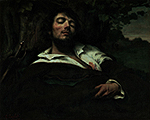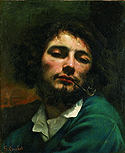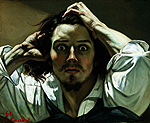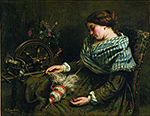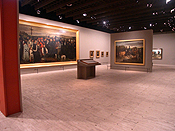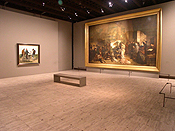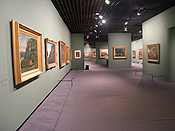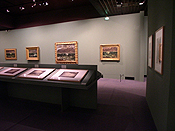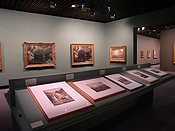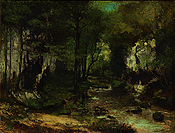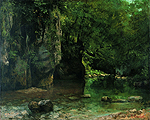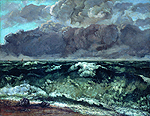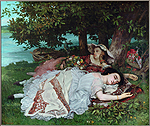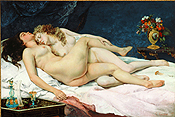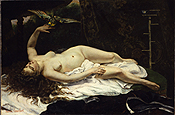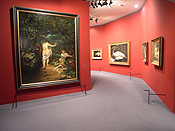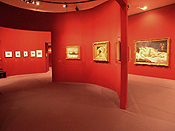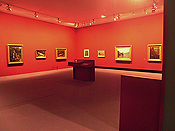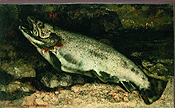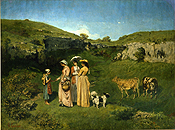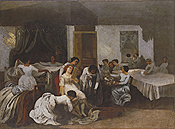The browser will either open the file, download it, or display a dialog.
|
|
Gustave Courbet Catalogue: English version: Metropolitan Museum of Art |
|||
|
The most ambitious monographic exhibition in a generation devoted to the art of Gustave Courbet opened in the Galeries nationales du Grand Palais, Paris, on October 13, 2007. It was organized by the Réunion des musée nationaux and the Musée d’Orsay, Paris, with the Metropolitan Museum of Art, New York and the Musée Fabre, Montpellier. Courbet, who during his life had a passionate love-hate relationship with France, was celebrated in Paris as a grand old master. The lines in front of the Grand Palais were long, zigzagging through metal pens along the Avenue du Général Eisenhower, and the galleries were abuzz with engaged visitors. Although installed in a somewhat cluttered warren of low-ceilinged rooms, incapable of unleashing the spectacular power of the artist’s best work, it was one of the most compelling exhibition events in recent memory for specialists in nineteenth-century art. |
||||
|
Pity the curatorial team faced with presenting the monographic Courbet. The literature is overwhelming (name one major historian of nineteenth-century French painting who has NOT contributed to Courbet studies.) Courbet was himself a monumental art historical figure, whose art and public life transformed the profession of painting, from building a career, to exhibition strategies, to cultivating a market and manipulating the press. There has been an enormous amount of scholarly writing on these issues. An exhibition, however, is limited in its didactic capacities to largely visual material (at least it should be.) The decision by the curators, Laurence des Cars, Dominique de Font-Réaulx, Michel Hilaire and Gary Tinterow, to focus on the paintings at the expense of the kind of heavy, socio-historical contextualization that exercises professional educators and designers was felicitous. But how to organize the output of an artist who contributed meaningfully to every painting genre in the course of a highly productive, but wildly uneven 35-year career, whose oeuvre—unruly, baffling, outrageous, gorgeous—does not fit neatly into any practical art historical category (not Realism, in the end, nor Romanticism, nor entirely Modernism)? |
||||
|
The installation was rather conservatively arranged according to chronology and genre: early self-portraits, early figural works and portraits, large-scale Salon paintings of the late-1840s and 1850s, landscapes, later figural works and portraits, nudes, hunting pictures, and finally ‘late’ pictures: trout, apples, Swiss landscapes. This plan was most successful in the first gallery, where one saw the young handsome artist developing his identity, and aggressively positioning himself before the public, with a series of self-portraits made between 1842 and 1852: the provincial dandy with an English flair in Self-Portrait with Black-Dog (1842), with his walking stick and sketchbook perched behind him; the sensual Romantic with heavy eyelids and voluptuous mouth, in Man with a Leather Belt, The Wounded Man, and Self-Portrait with a Pipe; the brow-furrowed musician in The Cellist; and the gripping Desperate Man (figs 1-3). The latter, used to spectacular effect in the promotion of the exhibition in both Paris and New York, shows Courbet staring out, eyes fixed with a hallucinatory intensity, muscled forearms and hands tearing at his hair |
||||
|
In addition to posing and preening (and establishing a kind of artistic celebrity so familiar to us today), Courbet explored internal states of being in these early autobiographical paintings. The tension between a materialism that would eventually be called Realism, and the exploration of psychological and emotional states more associated with Romanticism, is evident in many of Courbet’s works of the 1840s and 1850s, most pointedly in this exhibition in the images of women asleep, dreaming (fig. 4). It is also felt in the most ambitious painting of his early career, After Dinner at Ornans, a casual, ostensibly un-posed, scene of a group of men sitting in a small, darkly lit space made stuporous by digestion, fatigue, tobacco, alcohol and music. There is an immediate presence to this scene, as we are invited to empathize with one or more of these introverted states, and to feel as if we are sitting at an adjacent table in the same cavernous, smoke-filled room. |
||||
|
Particularly given the official success of After Dinner at Ornans, it seems that Courbet could have remained a productive genre painter. One glimpses clues, however, not only of deeper ambitions but also of strange, dark eccentricities that might not have been contained by a career as a painter of genre. As Courbet portrays his friend Paul Ansout, for instance, both of them in their early 20s, the painter seems to fixate on the weirdly crumpled ear between the sitter’s fist and cheek, and on the light-struck chair corner jutting out between his legs. In the wonderful portrait of his sister, Juliette, of the same period, Courbet becomes fascinated by the pattern of the chair caning, with its shadow cast on his sister’s back. There is an unnerving contrast between the crisply defined lace collar and cuffs and hard-edged pattern of Juliette’s blouse, and her broad forehead, wide eyes, and the decorative arabesque of her ear. It is this strange current in Courbet’s figure painting, described by Linda Nochlin as ‘perverse realism,’ that inspired such twentieth-century artists as Balthus and John Currin. |
||||
|
The mildly perverse portraits of Bruyas feel somewhat appropriate given what we know of that strange man, the ‘Maecenas of Montpellier.’ Courbet had an intense and complicated relationship with Bruyas, his most committed patron, particularly during his early career. In the three portraits included in the exhibition, Bruyas appears sunk into his body, his beard billowing over most of his face, his gaze passive. There are intimations of both sickness and strength in the most imposing of these, subtitled Painting Solution in reference to the mission contrived by Courbet and Bruyas to steer modern art in the ‘right’ direction. Bearing a signet ring on his index finger, Bruyas’s left hand, veins bulging, crouches on the large green tome inscribed with the title, Études sur l’art moderne. Solution. A. Bruyas. |
||||
|
The effect of Courbet’s paintings in altering the course of modern art was much more successful than his collaboration with Bruyas, and the hubris involved in conceiving, painting and actually submitting a work like the 17 x 22 foot Burial at Ornans to the 1850-51 Salon still impresses. The opportunity to see this painting outside the Orsay, even in the cramped galleries of the Grand Palais, was itself worth the price of the trans-Atlantic flight. Hung floor to ceiling, the painting wholly envelops the viewer, with the villagers of Ornans arrayed just above eye-level, the freshly dug grave gaping at our knees (fig. 5). One is able to engage with each figure individually, ranging in emotion from deep mourning to distraction, impatience and boredom. The haunting effect of several female figures, one of them dead center in the composition, pressing white handkerchiefs over their eyes with black gloved hands, is hard to shake. Burial remains a viscerally gripping work in a way that Studio of the Artist, for all its art historical centrality as a manifesto, does not, though the chance to study that signature painting at close range was also extremely valuable (fig. 6). |
||||
|
After his epic paintings of the early and mid 1850s, Courbet turned increasingly to producing and exhibiting landscapes. The scholarly estimation of Courbet’s achievement in this genre has been contested since the 1860s, rising and falling according to various critical and art historical imperatives. Further complicating a firm sense of his achievement in this genre are issues of both condition and attribution, exacerbated by the painter’s persistent unevenness, and by his technical experimentalism. Determining the difference between an over-cleaned Courbet, in which the layers of pigment have been unintentionally removed leaving an effect of crudeness, and works painted only partially or not at all, by Courbet can be very tricky. Furthermore, included in his oeuvre are paintings done quickly and/or carelessly, or under the effect of the artist’s lifelong alcoholism. Is the problematic Lons-le-Saunier Grotto of the Sarrazine due to condition, or is it the work of a clumsy follower/forger? Hung in Paris nearby (and in New York directly beneath) the pristine Getty Museum painting of the same subject forced the issue. Alongside other paintings similarly preserved, the Getty’s Grotto helps establish for viewers today a standard of complexity of surface and painterly finesse that should serve curators and conservators dealing with attribution and conservation issues. Other paintings in excellent states that come to mind include the portrait from Lyon of Paul Chenavard, Chauveroche, Valley at Ornans (private collection), the Baltimore Museum of Art’s Puits Noir, the Shelburne Museum’s Fruit in a Basket, Girl with Seagulls, Trouville (private collection), and the Metropolitan Museum’s Fishing Boat. |
||||
|
Though they constitute over two-thirds of his oeuvre, landscapes comprised no more than a quarter of the paintings within this broader monographic project (figs. 7-9). (And this despite the acknowledgment in wall texts and in the catalogue that “Courbet was first and foremost a landscape painter.”) Many of his greatest moments as a landscapist were represented, nevertheless, in Paris and to a lesser extent New York. Three of the best of the Puits Noir series showed Courbet grappling with the same familiar corner of the river Brême just outside Ornans over a period of more than a decade (figs. 10-11). Here Courbet was encouraged by the positive response of collectors to the subject, but clearly he was also driven by an aesthetic compulsiveness, a drive to deconstruct the spatial and light effects of this motif that would later establish the point of departure for Cézanne. |
||||
|
The appeal of Courbet’s most iconic landscapes has assured these pictures an unfortunate fate in the hands of restorers. The complex effects of light filtering through the leaves and reflecting off the stream and rocky facets of the National Gallery of Art’s Puits Noir have been reworked by well-intentioned campaigns of cleaning and in-painting. The majestic Oak at Flagey has been flattened and made hard as a board from an aggressive re-lining. Courbet’s blacks, so central to the power of his palette, seem to be particularly tricky to clean, affecting all of the Source of Loue pictures. The National Gallery of Art’s Source, in which the dramatic black center has been cleaned down to its dark brown underpaint (with the impastoed rock face in much better condition, as with all the paintings in this series) is usually relegated to off-site storage. The Hamburger Kunsthalle version seems to be in the best shape, and it was thrilling to see it in Paris with the Albright-Knox and Metropolitan Museum Sources. |
||||
|
Courbet’s inspired production on the Normandy shore, where the artist was transfixed by the natural drama of the rocky coastline, was represented by the sublime Wave, (Berlin Nationalgalerie) churning forth in all its thundering power, and by the pendant paintings, Stormy Sea and The Cliff at Étretat after the Storm, exhibited to critical acclaim at the Salon of 1870 (fig. 12). Missing was a critical mass of the marvelous tonal pictures of sky, sea and sand that Courbet dashed off during the summers of 1865 and 1866, so striking in their compositional minimalism and serialization. The glorious Immensity, (Victoria and Albert Museum) larger than most of these compositions, is a testament to the artistic and market success of this series; Courbet himself was amused at how well they sold, and with so little effort. Also largely absent in the group of landscapes was more than one snowscape. The heavy snowfall in Ornans of the winter of 1866-1867 particularly inspired Courbet, leading to some exquisite landscapes that proved a great inspiration to the next generation of avant-garde painters. |
||||
|
Courbet’s physical immersion in his motif, his tendency to collapse the distance between the beholder and the thing pictured, is most provocative in his paintings of nude women, every one of them charged with erotic energy. Although Ladies on the Bank of the Seine participates in the genre of suburban leisure imagery, of pretty girls in fashionable dresses relaxing by the river on a summer day, Courbet aggressively mines the erotic potential of such a scenario, in which dresses come off, bodies are flung on the bank in abandon, seemingly pleasured by the earth beneath them (fig.13). In a drugged or post-coital stupor (or both), the woman in the foreground lasciviously gazes out under heavy, half-closed lids, her body dissolving under the patterned folds of her dress. A dense flow of visitors shuffled by the ample breasts and bottoms of Woman in the Waves, The Source, and The Bather; the orgasmic Woman with a Parrot, with the bird’s priapic perch standing dumbly at the foot of the bed; and Courbet’s erotic masterpiece, Sleep, all flushed flesh, fingered folds and inadvertent holes (figs. 14-15). There was a hot house, peep show element in the Paris installation, which had these pictures set in a circular gallery, in the center of which were more circular walls containing the Origin of the World, the most celebrated beaver-shot in the history of painting, placed within the context of contemporary pornographic photography of similar headless, armless, legless compositions (figs. 16-17). Here, Courbet is shown to have responded to erotica modernized by photography, in which fantasy and idealization have been significantly stripped back to offer up female sex, very real and very physical. |
||||
|
The crucial question of the influence of photography on Courbet’s art, although thoroughly investigated in recent scholarship, was persistently posed in this exhibition, guided by the expertise of de Font-Réaulx, a photography curator at the Musée d’Orsay. The relationship between the new medium and Courbet’s imagery was most compelling in the installation of nudes and landscapes (fig. 9). The originality, intensity and vitality of Courbet’s representations of landscape motifs and of nude women were undoubtedly affected by the new visual modes introduced by photography. Contemporary nude and landscape photography further sensitized Courbet to issues of framing and cropping, lighting, and focus, not to mention the realist, “found-in-nature-ness” of the compositions. The installation of relevant photographs in the exhibition made the case visually. |
||||
|
Courbet’s painterly investigation of nature, power, sex and death came to a profoundly moving climax in the high point of the Paris installation, the gallery of hunting paintings, a traditional genre to which Courbet made a unique contribution. Himself an avid hunter, Courbet learned the sport in his native Franche-Comté, but he had one of his most successful hunts during a visit to Germany in the winter of 1858-59. The German Hunter presents the encounter between a small hunting dog, leashed to his master, and a murdered stag in rigor mortis. The domestic tameness of the black and brown snouted dog, painted in smooth, careful brushstrokes, is juxtaposed with the horrific visage of the deer, his eyes bulging, his tongue hanging out of a gaping mouth, the sharp tips of his antlers curving menacingly in the light. Courbet’s fast, violent strokes to depict the deer’s head give it a dynamic, screaming presence. |
||||
|
In another epic meditation on the death of these magnificent animals, Stag at Bay, the beast leaps to his defeat in a dusky, desolate landscape, his eyes and antlers turned upwards, mouth open as if crying out, all of this painted on a grand scale. It is an emotional distillation of Courbet’s greatest, post-Burial painting, the Death of the Hunted Stag, among the last great history paintings of the French tradition. Completed in 1867, this portrayal of heroic majesty humiliated, persecuted, tortured by a lowly pack of excited dogs despite the efforts of their whip-bearing master, has irresistibly biographic associations: Christ’s persecution at the hands of the Romans, or Courbet’s suffering during the final years of the repressive Second Empire? |
||||
|
The hunted animal, trapped and struggling for life, reaches its most concentrated expression in the late trout paintings, three of which are included at the end of the exhibition (figs. 18-19). While the artistic challenge of painting fish scales has ample art historical precedent, the function of these images as personal allegory is irrefutable. Painted in 1872 and 1873, immediately after the Commune and Courbet’s incarceration for his participation, they are both deeply moving and impressive examples, given his truncated life, of Courbet’s late style. Equally breathtaking was the adjacent installation of fruit still lifes, with those from the Shelburne Museum and the Ny Carlsberg Glyptotek confirming the painter’s mastery in this genre as well. |
||||
|
And then it ends, and one wonders what Courbet would have done through his sixties and seventies had he lived to paint more still lifes, landscapes, portraits, history and genre paintings. |
||||
|
The installation of the exhibition at the Metropolitan Museum of Art had to be by necessity a different kind of show, that is, not a proper monograph, given the impossibility of the artist’s greatest achievements traveling across the Atlantic. The beautifully scaled Met galleries were a relief after the crowded spaces and low ceilings of the Grand Palais. However, while there were some very memorable moments, one felt that the New York exhibition was inherited, with unfortunate alterations, and that the paintings were made to fit into a rubric, and forced into an inflexible floor plan. |
||||
|
After the first gallery, and its splendid triptych of self-portraits on the central wall, the exhibition lost some of its energy and focus. The gallery devoted to “Ornans paintings” did not hold together visually, with the strongest painting, the Met’s own Young Ladies of the Village, hung among lesser pictures that failed to engage it in meaningful dialogue, or enhance or unpack its mystery (fig. 20). (According to Champfleury, the painting was almost as scandalous as the Burial.) Related paintings such as the White Bull and Blond Heifer, (Galerie Nathan, Zürich) the Leeds City Art Galleries’ study for the composition, the Brussels Musée Royaux des Beaux-Arts’ Landscape at Ornans, and La Roche de dix heures, (private collection), none of which were included in the exhibition, would have created a fascinating case study of Courbet’s artistic process. Opposite Young Ladies of the Village hung a painting that was somewhat overwhelmed in the Paris installation, alternately known as Preparation of the Dead Girl and Preparation of the Bride, the jury apparently still out as to whether this is a bridal or a funeral scene (fig. 21). The absence of The Studio and Burial was predictably awkward. While there was no reproduction of the Burial to be found, a faint, scale reproduction of The Studio was screened onto a wall with paintings hanging over areas of the reproduction to which they relate. These relations, however, were inconsistent and occasionally misleading as in the Cuvelier photographs of workers, and most of the pictures were difficult to see properly in their attempt to hang near their ‘associates’. |
||||
|
The long gallery not so meaningfully titled “Painter of Modern Life” held nine paintings, mostly figural, along one wall, and eight along another, resulting in a rather laborious viewing experience. Extraordinary works, among them two versions of the Jo composition, were lost in the litany. One of the great Courbet treasures in the United States, The Girl with Seagulls, Trouville, a combination genre, portrait, and still-life/hunting trophy painting, was more fortuitously hung on a short wall in this gallery, with only one other picture (to which, alas, it had little to say.) The limitations of the existing gallery architecture on the installation was also apparent in the crowded gallery of nudes, and in the necessity to disperse the landscapes beyond the compact gallery devoted to them. |
||||
|
Whereas in Paris, the integration of photography into the installation felt more natural, with relevant prints displayed in cases in the center of paintings galleries, at the Met the photographs dominated a single gallery, with landscape paintings forced in along the edges. The more marvelous among them, paintings such as La Roche Pourrie, Forest of Fontainebleau, and Calm Sea, felt demoted in service to the curatorial argument about the exchange between Courbet and mid-century landscape photography. |
||||
|
How could one have made the Met version of the exhibition more compelling? One possibility might have been to abandon the attempt to survey the whole, and instead conjure a tighter show of singularly superb works, installed primarily for impact rather than chronological or typological clarity. Surely Courbet, of all nineteenth-century French artists, deserves a provocative installation. Curators could have reconstructed moments of Courbet’s own exhibition strategy, and his sense of the relationships between his paintings, of series and pendants, and of large public paintings versus smaller, more marketable ones. Or what if, as recently suggested by a Los Angeles artist, the exhibition opened with the Origin of the World, right there on the central wall in the first gallery, out in the open instead of discretely hidden away? Given the pervasiveness of pornographic images in contemporary culture, such a move would have been less about shock than establishing relevance. It is a wild idea, and may not have worked, but wouldn’t Courbet have been pleased? |
||||
|
The exhibition is accompanied by an enormous doorstop of a tome, 472 pages, six essays, extensive plate entries, and back matter including a chronology, an anthology of seminal primary documents, a bibliography and an exhibition history. Once again, the question must be posed: what is the function of a publication like this? Is it to advance scholarship? To serve as a comprehensive, in-depth introduction to the museum-going public? A reference tool for scholars? A textbook for students? Given the extraordinary expense and labor that go into these productions, it is striking that their function continues to be so ill-defined. |
||||
|
Rather than advance significant new interpretations of Courbet, or present important new research, this exhibition catalogue offers musings on several relevant themes in considering Courbet’s oeuvre today. Though most of the authors have contributed to the literature on Courbet, none, save perhaps des Cars, could fairly be called Courbet scholars. There is a general attempt by des Cars and de Font-Réaulx to place Courbet’s work within the history of nineteenth century, mostly French painting, as opposed to further excavations into socio-political context. The influence of photography, as in the installation, plays an unprecedented role in the consideration of Courbet’s realism and in the creation of specific paintings in essays and entries by de Font-Réaulx. Another reconsideration of Courbet’s complex politics, by Bertrand Tillier, is certainly welcome given the impassioned, but sometimes vaguely founded notions of the artist as politically engagé. Tillier examines the confusion between Courbet’s artistic and utopian ambitions and the political expectations of critics responding to his paintings. Bruno Mottin’s essay presents the results of technical examinations of Courbet’s paintings, sadly rare in the field, which shed light on the artist’s practice, and supports the notion of his process as highly experimental and technically innovative. Representing his museum, Michel Hilaire writes about the complex and crucial role of the Montpellier collector and art advocate Alfred Bruyas in Courbet’s project. The odd insertion of an essay in this book, to accompany the even odder ‘interjection’ in the Grand Palais installation, on the photography of the Swiss artist Balthasar Burkhard, was an attempt to connect Courbet’s project with contemporary art. While the photographs are beautiful and clearly inspired by the work of Courbet, one wondered, why this artist of all those affected by Courbet practicing today? |
||||
|
The catalogue reproductions are mostly high quality (unlike those in two recent large Courbet monographs published by Adam Biro and by Éditions Citadelles & Mazenod) and offer a compilation of good photography of some 140 paintings from across Courbet’s career that is extremely useful, particularly given the fact that the catalogues raisonné are almost thirty years old. Plate entries are quite thorough and elegantly written, divided among the team of authors listed above. They are preceded by provenance and exhibition histories, the latter not always complete. For example, the very first Salon acceptance of Courbet’s career, Self-Portrait with Black Dog, is not listed as having been exhibited in Paris until 1882; the presence of The Peasants of Flagey Returning from the Fair in Courbet’s crucial 1850-51 Salon contribution is not listed in the exhibition history. The chronology, written by Dominique Lobstein, is helpful though it is difficult to identify all of the paintings he tracks by title (he does not use catalogue raisonné numbers). Similarly, the location of so many of the paintings are unknown that one wonders how much of a priority this crucial kind of sleuth work was while developing the exhibition (and one is made more impatient for the issue of one or both of the Courbet catalogue raisonné projects currently under way). It may have been too complicated logistically to notate which pictures were included in which venue of the exhibition, but because the checklist was reduced in New York (and presumably Montpellier) this would have been helpful. The English version of the RMN produced French catalogue was published for the Met by Hatje Cantz, and the print quality of the illustrations were even better in this version, though it would have been helpful to have the titles of the paintings in the plate section in both English and French. In the end, the reader is left with a helpful, though very heavy and expensive book that commemorates an extraordinary opportunity to steep in the rich, multi-faceted, consistently confounding and undeniably powerful paintings of one of the most important artists of the nineteenth century. |
||||
|
The model for this kind of project is imperfect in so many ways, not least of which is the fact that the revision of an artist’s oeuvre that is at the heart of the monographic mission can only come about on the occasion of the exhibition, rather than a year before the opening date, when catalogue writing is due to the publisher. There have been some very interesting movements in Courbet studies in response to the exhibitions of his work over the last couple of years, the earliest iterations of which have occurred at various symposia. The curatorial team who assembled this epic installation and tirelessly wove together text for each object, elucidating many of the central themes of Courbet studies in the process, has granted an opportunity for a new generation of scholars, artists and the museum-visiting public to gauge the merits and relevance of the ‘master of Ornans.’ The State of the Question is very much alive, surely the primary gauge of the success of Gustave Courbet. |
||||
|
Mary Morton |
||||


